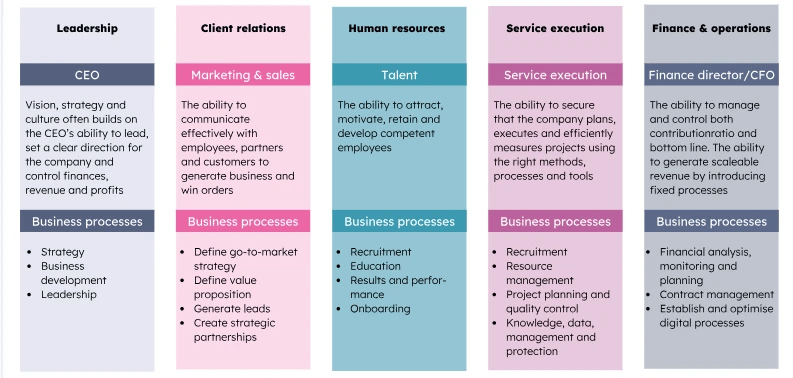Examples of Professional Services Automation software on the market
9 min read
Time tracking
Build your perfect data foundation for spotless invoicing and deep business insights with easy time tracking.
Project management
Be a world champion project manager. Keep your projects on track - and profitable.
Resource management
Efficiently staff projects and run a predictable business with confidence.
Insights & Reporting
Get smarter - faster - to make clever decisions for long-term growth impact.
Project accounting & Invoicing
Invoice everything - fast and accurate - while staying on top of project finances.
Staff & Salary
Give accountants and HR an intelligent tool to eliminate draining administration.
Financial Systems
TimeLog offers standard integrations for all your favourite financial systems. Save time and reduce manual tasks.
Payroll Solutions
TimeLog offers standard integrations for multiple payroll solutions. Get easy salary administration and only enter payroll information once.
Add-ons
Track time automatically via Outlook, use gamification or find another add-on that can support your business.
Multiple Legal Entities
You can create synergy between your departments and across borders and offices with the Multiple Legal Entities module from TimeLog.
Business Intelligence
Utilise the insights you get from TimeLog to the fullest. Our system is ready to integrate with multiple BI solutions.
Partner Integrations
TimeLog PSA is part of a large ecosystem. Get an overview of all the partner integrations in the TimeLog family.
Economy department
Save 1-2 days a month on your invoicing process.
Project teams
From planning to execution and evaluation. Robust tools for every project manager.
Management teams
Create a performance-driven culture with solid reporting capabilities.
Large enterprises
Enhance operations and performance across entities, countries and departments.
NGOs and non-profit organisations
Simplify internal processes, spend less time on administration, and get documentation in place - at a discounted rate.
Blog
Get inspired to run an even better business with articles, guides and analyses.
Guides, podcasts and webinars
Get access to templates, guides and webinars that help and inspire you.
Help Center
Looking for help material and user guides to the TimeLog system? Look no further. Find all the help you need now.
Get a single source of truth
Discover how companies maintain a single source of truth across borders, departments, and currencies.
Get integrated
Discover the advantages customers gain from utilising our integrations and API.
Reporting in real-time
Explore how others leverage reporting to optimise their processes and make informed decisions.
Get started with resource planning
Discover how other companies thoroughly grasp their resources and enhance their ability to predict future trends.
Improved project financials
This is how the efficient financial toolbox from TimeLog helps project managers and CFOs improve their project financials.
Faster invoicing
Discover how other companies have slashed the time spent on invoicing by 75% - and uncover how you can achieve the same efficiency.
The Story of TimeLog
Get insights on TimeLog and how we can help you grow and evolve your business.
Employees
See who shows up every day to deliver the best PSA solution.
Career
What's life like at TimeLog? Are we hiring? Get the answer here.
Partner
Create even more value for your customers, as well as ours, as a TimeLog Partner.
Premium Service
Online Help Center, tailored onboarding and support from Day 1.
Corporate Social Responsibility
We work to ensure a positive impact on planet, people and businesses.
Security and GDPR
Learn more about how we work to keep your data safe and provide maximum security.
2 min read
What I learned about leadership from the Professional Services Industry Benchmark and how you can use the knowledge to improve your leadership too.

In the podcast Beyond the Benchmark, I recently discussed the five pillars of the maturity model, developed by Service Performance Insight (SPI), focusing on the leadership pillar.
Dive into the podcast right here – or read on and get key takeaways in this article.
Let's start by delving into the foundation of the PS Maturity Model and its connection to leadership.
The PS Maturity Model™ is a strategic planning and management framework developed by SPI in 2007.
The maturity model is part of the Professional Services Industry Benchmark that gives the industry a status based on more than 150 KPIs yearly.
The model is based on optimising five Service Performance Pillars: Leadership, Client Relationships, Talent & HR, Service Execution, and Finance & Operations.
For each pillar, we can measure a certain level of maturity.

First, mature leadership is not measured in years. But mature leaders are the ones able to:
In other words, successful leadership is defined by communicating a clear vision and strategy, aligning the company's goals with its commercial interests, and inspiring employee confidence.
Maturity in leadership is a prerequisite for and an effect of the company that can grow and evolve. As the company matures, it can better handle growth and development challenges. But it must be supported by strong leadership.
Leadership is essential for guiding a company through the maturity model levels. At each level, the company faces new challenges and opportunities, and the leader's role is to navigate these changes and steer the company towards success.
This requires strategic thinking, commercial understanding, and inspiring and motivating employees.
The role of leadership will become even more critical.
With the rise of new technologies such as AI and machine learning, companies must be agile and adaptable to stay competitive. Leaders must be open to new ideas and willing to embrace change to keep their companies at the forefront of their industries.
But that’s not all.
We will see teams and organisations change as we have a man and machine-workforce mix.
The leaders who stay ahead in the game will be willing to keep learning, testing, and being wrong. For leaders and companies, the truth is that whatever got you here won’t get you further. This means we must embrace new technologies, ways of working, and ways of leading and managing.

"I bring over 17 years of international leadership experience, with a proven track record in Customer Satisfaction, Employee Satisfaction, Business Growth, and Leadership within Information and Communication Technology," shares Pelle.
Connect with Pelle on LinkedIn to learn more about his insights and expertise in the industry.
You can find all the podcast episodes where you usually listen to your podcasts. Alternatively, you can also check out an overview on our website now.

9 min read
 Read more
Read more
 Read more
Read more

6 min read